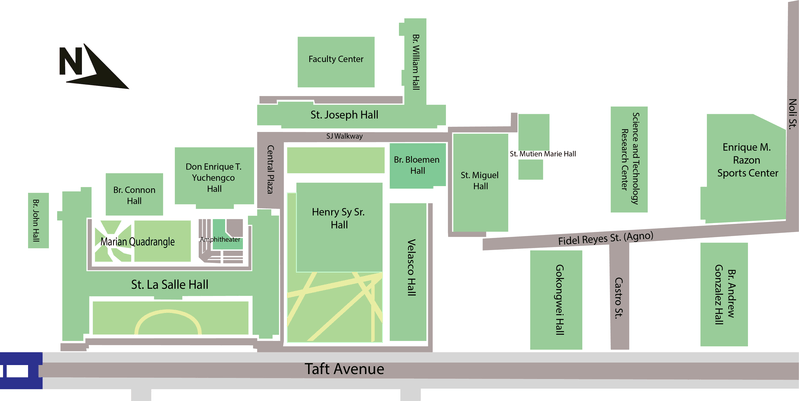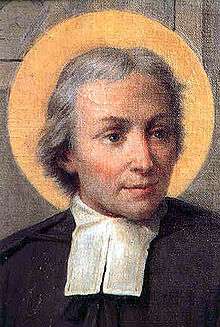De La Salle University
De La Salle University (Filipino: Pamantasang De La Salle, Unibersidad ng De La Salle), also known simply as La Salle and abbreviated as DLSU, is a private, Catholic research university run by the De La Salle Brothers located in Taft Avenue, Malate, Manila, Philippines. It was established in 1911 as the De La Salle College (DLSC) in Nozaleda Street, Paco, Manila with Br. Blimond Pierre FSC serving as first director.[2] The educational institution moved to its present location in 1921 to facilitate the increase in enrollment. The college was granted university status on February 19, 1975 and is the oldest constituent of De La Salle Philippines (DLSP), a network of 16 Lasallian institutions established in 2006 to replace the De La Salle University System.[1][14][15]
Pamantasang De La Salle Unibersidad ng De La Salle | |
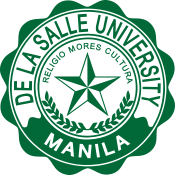 | |
Former name | De La Salle College (1911–1975) |
|---|---|
| Motto | Religio, Mores, Cultura (Latin) |
Motto in English | Religion, Morals, Culture |
| Type | Private Roman Catholic research non-profit coeducational higher education institution |
| Established | June 16, 1911 (109 years and 62 days)[1][2] |
Religious affiliation | Roman Catholic (Christian Brothers) |
Academic affiliations | |
| Endowment | ₱286 million (US$6.52 million)[7][8] |
| Chairman | Mr. Nestor V. Tan |
| Chancellor | Br. Bernard S. Oca, FSC |
| President | Br. Raymundo B. Suplido, FSC |
Academic staff | 1,285[9] |
| Students | 16,704 |
| Undergraduates | 11,527[9] |
| Postgraduates | 5,177[9] |
| Address | 2401 Taft Avenue, Malate , , , 1004 , |
| Campus | Manila: Urban 5.45 ha (13.5 acres)[10] Laguna: Suburban 50 ha (120 acres)[11] |
| Hymn | Alma Mater Hymn |
| Colors | Green and White[12] |
| Athletics | Varsity team names: Green Archers (College men's varsity teams) Lady Green Archers (College women's varsity teams) Junior Green Archers (High School boys' varsity teams) Junior Lady Green Archers (High School girls' varsity teams) |
| Nickname | Green Archers |
Sporting affiliations | |
| Sports | See list |
| Mascots | Gordo, Flaco and Sally |
| Website | dlsu |
The university started as a boys' elementary and high school. In 1920, it began offering a two-year Associate in Arts Commerce program, which was later discontinued in 1931 in favor of a Bachelor of Science in Commerce program.[16][17] DLSU currently offers coeducational undergraduate and graduate degree programs through its seven colleges and one school specializing in various disciplines, including business, engineering and liberal arts.[18] Students and alumni from La Salle were previously referred to as Lasallites, but the term has since been changed to Lasallians.[19] The patron of the university is St. Jean-Baptiste de La Salle, the patron saint of teachers and all those who work in the field of education.[20] He is also the founder of the De La Salle Brothers and Lasallian educational institutions.[21]
DLSU is cited by the Philippine Commission on Higher Education (CHED) as a "Center of Excellence" in 14 of its programs, and a "Center of Development" in 5 of its programs.[22] The university is also among the 40 institutions granted autonomous status by CHED as of 2010.[23] Likewise, it is the first of the only two institutions granted the highest-level accreditation (Level IV) by the Philippine Accrediting Association of Schools, Colleges and Universities (PAASCU).[1][24] The university is a member of several international university associations, including the ASEAN University Network (AUN) and International Association of Universities (IAU) as well as local organizations such as the South Manila Inter-Institutional Consortium.[3]
De La Salle University ranks 156th and is in the 801-1000 bracket of the 2020 QS Asian University Rankings and 2020 QS World University Rankings, respectively, published by Quacquarelli Symonds (QS).[25] Times Higher Education (THE) included De La Salle University in its 2019 edition of Times Higher Education World University Rankings where DLSU was placed in the 801-1000 bracket, which also marked the university's first appearance in the rankings.[26] It joined the University of the Philippines as the only two universities in the Philippines to enter the list,[27] and is the only private university from the Philippines to be included.[28] DLSU also made its debut appearance on the Times Higher Education Asia University Rankings in 2019, where it was placed in the 251-300 bracket.[29] Presently, De La Salle University holds the distinction of being the lone Philippine private university to appear in both the QS World University Rankings and the Times Higher Education World University Rankings.
History

The Philippines was one of the last Southeast Asian countries that the De La Salle Christian Brothers established themselves in. The country before 1898 was dominated by several Spanish religious orders. Several years before the De La Salle Christian Brothers were invited to the Philippines, the local American government ordered Ateneo to modernize and use English as a mode of instruction, but the Spanish Jesuits refused and argued that their allegiance was with Spain. The Americans, after knowing this, made the decision that it would be best for the De La Salle Christian Brothers (FSC – Fraternum Scholarum Christianarum) to take over the task. The Christian Brothers have established several De La Salle schools worldwide that provided Christian values-based education in 35 countries at that time. The Americans have always known that the De La Salle Christian Brothers were up to the given task due to the Brothers' main religious vocation was Christian values-based education. The De La Salle Brothers used innovative teaching methods since their formation in 1725 making them highly knowledgeable, capable, and qualified in providing modern education to the young Filipinos in Manila.
Initially, the De La Salle Brothers were very hesitant in establishing a De La Salle school in the country because the Americans insisted that the first De La Salle school should only educate the rich children of the Filipino ruling elite. The Americans ordered the Christian Brothers to Americanize future Filipino leaders through their Catholic Lasallian education. The American request had put the De La Salle Brothers in a dilemma because it ran contrary to the original teachings and charism of Saint Jean-Baptiste de La Salle, the patron saint of teachers whose religious vocation was to provide tuition-free, quality Christian values-based education. The De La Salle Brothers eventually relented, conceding that the “upper-class children also needed good moral and spiritual training." Saint La Salle's mission was to empower the last, the least and the lost among the poorest children in the world in order to free them from the shackles of ignorance that creates poverty.
De La Salle University traces its founding roots to then Manila Archbishop Jeremiah James Harty. Harty, an alumnus of a Christian Brother school in St. Louis, Missouri, United States believed that the establishment of a De La Salle school in Manila would be instrumental and vital in preempting the spread of Protestantism in the Philippines through the arrival of the Thomasites and American Protestant church missions.[30] His request would be later endorsed in 1907 by Pope Pius X. An envoy of De La Salle Brothers arrived in 1910. Together with Manila Archbishop Harty, the Brothers searched for a suitable campus. A 13,000 m2 (140,000 sq ft) property in Paco, Manila was purchased for this purpose.[31]
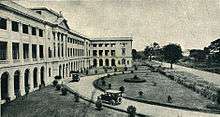
Early history
Br. Blimond Pierre Eilenbecker FSC, Br. Aloysius Gonzaga McGiverin FSC, and Br. Augusto Correge FSC, arrived in Manila[32] on March 10, 1911.[33] In two months time, on May 13, the six remaining Brothers of the Founding Community arrive in Manila. They were Br. Ptolomee Louis Duffaux FSC, Br. Goslin Camillus Henri FSC, Br. D. Joseph FSC, Br. Celba John Lynam FSC, Br. Imar William Reale FSC and Br. Martin FSC. De La Salle College officially opened its doors to 125 pupils on June 16, 1911. By July 10, the total number of students reached 175.[34]
On February 12, 1912, the college was incorporated under the sole ownership of the college director, who was then Eilenbecker.[34] Around this time, four more Brothers arrived to teach in Manila in response to Br. Blimond's request for more Brothers to handle the increased teaching load. There were two Frenchmen – Br. Wilfrid FSC of St. Joseph's College, Hong Kong and Br. Basilian Coin FSC from St. Paul's Institution in Seremban, Malaysia; and two Irishmen – Br. Dorotheus Joseph FSC and Br. Egbert Xavier Kelly FSC, one of the younger Brothers to volunteer to the missions. All of them were from the Penang District which the Philippines was under. The college was permitted to confer high school diplomas in the same year. Meanwhile, it received a charter from the Governor-General of the Philippines, allowing the college to confer associate degrees in commerce.[35] It started offering the degree as a two-year program in 1920.[17]
The college already had 425 students by 1921. Due to the lack of space in the original De La Salle College Paco campus, along with the growing population of its student and faculty, the college moved to its present location in 2401 Taft Avenue, Malate, Manila.[17] In 1931, the college discontinued its two-year commerce program in favor of a three-year Bachelor of Science in Commerce program, which was approved a year earlier.[16][17]
Second World War and the Japanese Occupation of the Philippines (1942–1945)
A few hours before the Imperial Japanese Army forcibly took the "Open City" of Manila a contingent of young La Salle boys led by a De La Salle Brother walked from Taft Avenue all the way towards the pre-war Ateneo de Manila, Padre Faura campus, a school with whom it shared a rivalry. During the initial outbreak of the invasion of Manila by the Japanese Marines, several La Salle boys helped secure and save Ateneo's prized "Jesuit Bell" along with several valuable Jesuit religious antiques just before the Japanese shock troops could enter Manila and ransack the Jesuits' pre-war campus.
The American De La Salle Christian Brothers were interred in the Japanese Los Banos, Laguna Prison for the duration of the three-year Japanese occupation of the Philippines while the other non-American Brothers led by then-Brother President Br. Egbert Xavier Kelly FSC and Br. Flavius Leo FSC, both from Ireland, were allowed by the Japanese to stay in the Taft Campus.
Initially, the De La Salle campus served as a secret shelter for several displaced civilians, wounded soldiers and Filipino guerilla fighters at the beginning of the Japanese occupation. However, later on it was occupied by the Japanese forces, and was made into military defense quarters on January 2, 1942.[16] Several repeated bombings severely damaged the DLSC campus. Despite this, classes continued as the Christian Brothers taught on during the Japanese occupation of Manila. During this time, several of the De La Salle boys along with the Ateneo boys had to set their school rivalry aside and share their classrooms with each other along with several other students from various neighboring schools. Several schools in Manila had discontinued their operations and closed down due to the fall of Manila to the Japanese invading forces. The DLSC high school classes were later on transferred to St. Scholastica's College, Manila in 1943.[36][37]
The classes were eventually discontinued at the De La Salle campus. On February 1, 1945, Japanese forces ordered the occupants of the DLSC and the surrounding vicinity to vacate the college. However, Br. Egbert Xavier Kelly FSC refused the order to vacate. On February 7, 1945, he was abducted by Japanese soldiers, and was never seen again. He was believed to have been mercilessly tortured and killed. On February 12 shortly after noontime, 20 Japanese soldiers came and forcibly barged into the DLSC campus and massacred 16 of the 17 De La Salle Brothers residing in the campus, along with 25 other residents.[16] Only one De La Salle Brother (Antonius von Jesus) and 21 other civilians survived the tragic event.[38]
Post–war period
Classes resumed in July 1945 with a class of incoming freshmen that was composed of 60 high school graduates. One year later, the College of Commerce reopened with its three-year BS Commerce program extended to a four-year program.[16][36] The High School Department of De La Salle College on Taft Avenue, Manila was dissolved in 1968 and transferred to La Salle Green Hills on Ortigas Avenue, Mandaluyong in Metro Manila.[39] The college, together with Ateneo de Manila University, gave birth to the Asian Institute of Management in the same year with assistance from the Ford Foundation and Harvard University.[39][40] Several other units were established in the following years.
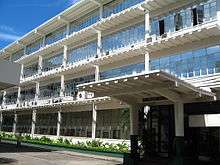
The 1970s marked substantial developments in De La Salle College. The school became co-educational in 1973. On February 19, 1975, De La Salle College was granted university status. Since then it became known as De La Salle University (DLSU).[1] It also used the name De La Salle University – Manila.[41] Since 2008, it has since referred to itself only as De La Salle University, being its registered name in the Philippine Securities and Exchange Commission.[42] The Grade School Department was deprecated in 1978.[6]
The 1980s were also significant for the institution. In 1981, De La Salle University shifted from the traditional semestral academic calendar to a trimestral one.[16] In 1987, the university, together with four other Lasallian institutions, became part of the De La Salle University System.[43] The system would later be dissolved in favor of De La Salle Philippines, a network of 16 Lasallian institutions. De La Salle–College of Saint Benilde (DLS-CSB) became independent of the university in 1988. Benilde offers college courses not offered in De La Salle University.
Recent history
An Mk 2 grenade was detonated outside the southern portion of the DLSU campus in front of a popular burger shop along Taft Avenue on September 26, 2010 at around 5:05 pm by opposing rival Law fraternities PST, the same day as the Philippine Bar exams conducted by the university.[44] The blast injured 47 individuals,[45] two of whom required limbs to be amputated.[46] Anthony Leal Nepomuceno was indicted by the Philippine Department of Justice on April 29, 2011, on the charge of detonating the device.[47]
In 2012, De La Salle Canlubang was formally merged with De La Salle University and became an extension of DLSU. It was inaugurated as the present-day De La Salle University Science and Technology Complex (DLSU-STC).[11][48] In 2015, DLSU announced that it would open its Manila campus for senior high school students in response to the K–12 implementation.[49] The Senior High School (SHS) classes officially opened on June 1, 2016.[50]
Campuses
Manila
_Campus%3B_Rizal_Memorial_Sports_Complex%3B_Harrison_Plaza_-_Aerial_Shot_(Taft_Avenue%2C_Malate%2C_Manila%3B_2015-06-25).jpg)
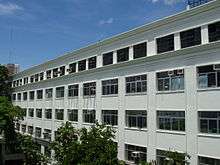
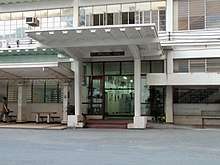

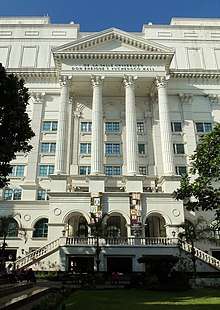
The main campus consists of 19 buildings (nine classroom buildings and 10 other buildings for administrative and auxiliary functions) located on a 5.45 ha (13.5-acre) lot in 2401 Taft Avenue, Malate, Manila. The campus faces to its right the main campus of De La Salle – College of Saint Benilde, a sister Lasallian institution, and the Vito Cruz Station of the Manila LRT Line 1. As part of the University Belt, several other colleges and universities, including St. Scholastica's College, Manila and Philippine Women's University, can be found near the campus.
The buildings have a combined floor area of 136,685.98 m2 (1,471,275.6 sq ft),[18] and mostly feature neoclassical design. These include:
- St. La Salle Hall, the first building in the campus. A four-storey neoclassical building,[51] its construction started in 1921 and was completed in 1924.[17] The building was designed by Tomás Mapúa, the first Filipino registered architect and subsequent founder of Mapúa Institute of Technology.[52] St. La Salle Hall was one of the very few Manila Buildings that survived the near total Destruction of Manila during the February to March Battle of Manila (1945). It has undergone retrofitting since 2010, and was completed in 2012.[53] The LaSallian, the official student newspaper of the university, identifies it as "DLSU's most historic building."[48] Likewise, it is the only Philippine structure featured in 1001 Buildings You Must See Before You Die: The World’s Architectural Masterpieces, a book published by Quintessence Editions Ltd. in 2007.[54] St. La Salle Hall also houses the College of Business and School of Economics.[55]
- St. Joseph Hall, a six-storey building completed in 1956.[51][56] It was the location of the DLSU library from 1956 to 1985.[57] It houses the College of Science and DLSU's Discipline Office.[58]
- St. Miguel Hall, a four-storey building completed in 1969.[59] Originally known as the St. Benilde Hall, it was renamed in 1989 and houses the College of Liberal Arts.[43]
- Velasco Hall, a five-storey building completed in 1981.[51] It houses the College of Engineering.[43]
- Don Enrique T. Yuchengco Hall, a nine-storey neoclassical building. Completed in 2002, the building hosts 20 classrooms, six conference rooms, DLSU's administrative offices and the Teresa G. Yuchengco Auditorium, a three-storey 1,100-seater auditorium. It has a total floor area of 12,254 m2 (131,900 sq ft).[60]
- Br. Andrew Gonzalez Hall, a 20-storey 90-meter tall neoclassical building, making it the tallest academic building in the Philippines.[18][61] It has a total floor area of 28,000 m2 (300,000 sq ft), and has parking space for up to 120 cars. The building, completed in 2006, houses more than 100 classrooms and faculty rooms, and the College of Education.[62]
- Enrique M. Razon Sports Center, a ten-storey neoclassical building that serves as the main sports facility of De La Salle University. It was built in 1998 to replace the old Brother Lucian Athanasius FSC Gym that was demolished in 2000 to give way for the construction of the Yuchengco Hall. The Sports Complex stands on a 3,155 square meter lot located at the corner of Fidel Reyes St. (formerly named Agno Street) and Noli streets. This large and modern complex houses an Olympic-sized pool and track and field oval with balcony. It has basketball and volleyball courts. It also has table tennis courts, a dance and martial arts studio, and weight training rooms. The lower floors house a sports clinic, canteen, and bookstore. The facility also displays the championship banners and retired jerseys of notable athletes.[63][64]
Construction of the Henry Sy Sr. Hall began on December 2, 2010 as part of the university's Centennial Renewal Plan, a project that aims to construct and renovate facilities inside the campus. A 14-floor building,[65] it replaced DLSU's football field with plans for completion by December 2012.[66] It is estimated to cost ₱1.4 billion (US$32.5 million).[7][67] In line with this, DLSU entered an eight-year agreement with the Philippine Sports Commission. Under the contract, DLSU will fund the ₱7.4 million (US$171,000)[7] renovation of the Rizal Memorial Track and Football Stadium. DLSU will get to use the facilities in return.[68][69][70]
The DLSU campus which is relatively small in size for its large student population, suffers from limited space. According to The LaSallian, each student had only 7.1 m2 (76 sq ft) for himself in 2009. Crowding is expected to only get worse as the university's population has been continuously growing with the growth for 2008–2009 amounting to 27.7 percent. It has also expressed concerns regarding fire safety, citing possible evacuation difficulties should a fire occur at the Br. Andrew Gonzalez Hall, and accessibility issues for fire trucks given the lack of wide roads to major buildings. At least three fires have occurred in the campus, including two at St. Joseph Hall.[71] To address the problem of limited space, DLSU has resolved to vertical expansion. However, this has resulted in overcrowded elevators.[18]
Manila Campus Map
Laguna
The Laguna campus is an extension of De La Salle University since 2012, and is located in Biñan City, Laguna, Philippines. The 50-hectare (120-acre) campus was built on land donated by the family of the late National Artist for Architecture De La Salle alumnus Leandro Locsin. It was originally known as De La Salle Canlubang (DLSC), a district school of De La Salle Philippines that provided science and technology-based primary, secondary, and tertiary education. In 2012, the administrations of DLSU and DLSC approved the integration of DLSC into DLSU, becoming the De La Salle University – Science & Technology Complex (DLSU-STC).[11]
As of 2018 only 0.6 ha (1.5 acres) of the Laguna campus is developed. Under the proposal, DLSU would expand the Colleges of Engineering, Computer Studies, and Science to DLSU-STC due to its location inside the Laguna Technopark.[72] DLSU fears, however, that it might lose some of its students due to the distance of DLSU-STC from Manila (around 42 km). DLSU-STC has two football fields.[48] By 2017, the Laguna campus offered 18 undergraduate degree programs.[73]
Makati Extension
The Makati Extension Campus is an extension campus of DLSU in RCBC Plaza, Ayala Avenue, Makati City, Philippines. The campus primarily serves the university's graduate business students.
Rufino (Bonifacio Global City)
In September 2013, the Bases Conversion and Development Authority (BCDA) has awarded to De La Salle University the lease and development of a 1,395 square-meter institutional lot in Bonifacio Global City in Taguig City. DLSU signed a contract with BCDA in October 2013. It is now the DLSU Rufino Campus College of Law provided by the Rufino family.[74][75]
Former
Ortigas Extension
In 2011, the Ortigas Extension Campus of the Ramon V. del Rosario College of Business moved from La Salle Green Hills in Mandaluyong City to the Ortigas Business District. The campus is located at the Wynsum Corporate Plaza, Ortigas Center, Pasig City, Philippines.
Organization and administration
| Directors | |||
|---|---|---|---|
| Name | Tenure of office | ||
| Blimond Pierre Eilenbecker | 1911–1912 | ||
| Goslin Camille Thomas | 1912–1915 | ||
| Acisclus Michael Naughter | 1915–1919 | ||
| Albinus Peter Graves | 1920 | ||
| Presidents | |||
| Name | Tenure of office | ||
| Albinus Peter Graves | 1921–1923 | ||
| Acisclus Michael Naughter | 1923–1927 | ||
| Celba John Lynam | 1927–1930 | ||
| Dorothy Joseph Brophy | 1930–1933 | ||
| Marcian James Cullen | 1933–1936 | ||
| Flannan Paul Gallagher | 1936 | ||
| Lucian Athanasius Reinhart | 1937–1945 | ||
| Egbert Xavier Kelly | 1945–1950 | ||
| Antony Ferdinand Kilbourn | 1946 | ||
| Andelino Manuel Castillo | 1950 | ||
| Hyacinth Gabriel Connon | 1950–1959 1967–1978 | ||
| Denis of Mary Ruhland | 1959–1961 | ||
| Crescentius Richard Duerr | 1961–1966 | ||
| Andrew Gonzalez | 1978–1991 1994–1998 | ||
| Rafael Donato | 1991–1994 | ||
| Rolando Ramos Dizon | 1998–2003 | ||
| Carmelita Quebengco | 2003–2004 | ||
| Armin Luistro | 2004–2010 | ||
| Narciso S. Erguiza, Jr. | 2010–2012 | ||
| Ricardo Laguda | 2012–2015 | ||
| Raymundo B. Suplido | 2015–present | ||
| Notes | Names in italics were acting presidents. | ||
| References | [76][77] | ||
As a non-stock incorporated entity, DLSU was headed by a 15-person board of trustees in 1992.[78] Presently, 17 members comprise the DLSU Board of Trustees.[79] The DLSU Board of Trustees, currently chaired by Nestor V. Tan, selects the DLSU President. As resolved by the Board of Trustees in June 2010, the president of De La Salle University must be a Lasallian Brother and be a holder of a PhD. Filipino citizenship is not a must but preferred. Prior to the university's move to its present location in 1921, the president was referred to as the director. The president and chancellor, currently Br. Raymundo B. Suplido FSC, and Br. Bernard S. Oca FSC, respectively, are assisted by four vice chancellors.[80] Prior to the reorganization of DLSU in 2007, the chancellor was referred to as the executive vice president.[81] The president may concurrently be the chancellor of the university, as with former President and Chancellor Br. Armin Luistro FSC.[82]
Since its establishment in 1911, De La Salle University has had 23 presidents (nine Filipinos, six Americans, six Irishmen, and two Frenchmen), with Br. Raymundo B. Suplido FSC serving as the current president.[79] All of them, except Carmelita Quebengco, were male. Two of them had been appointed as secretaries of the Philippine Department of Education, including Br. Andrew Gonzalez FSC (1998–2001)[83] and Br. Armin Luistro FSC (2010–2016).[84] Meanwhile, Br. Rolando Ramos Dizon FSC also a former DLSU, University of St. La Salle and La Salle Green Hills President, had served as the chairman of Philippine Commission on Higher Education from 2003 to 2004.[85][86]
Affiliations
De La Salle University is the oldest member of De La Salle Philippines, a network of 16 Lasallian institutions established in 2006. DLSP is the successor of the De La Salle University System, a similar organization.[14][15]
DLSU is also a member of several international university associations, namely: the ASEAN University Network, Association of Christian Universities and Colleges in Asia, Association of Southeast and East Asian Catholic Colleges and Universities, Association of Southeast Asian Institutions of Higher Learning, International Association of Lasallian Universities, International Association of Universities, International Federation of Catholic Universities, United Board for Christian Higher Education in Asia and University Cooperation for Internationalisation.[3][4] The university is also a member of local organizations, including the Philippine Association for Technological Education[5] and the South Manila Inter-Institutional Consortium.[6]
De La Salle Philippines, is a member of a 350-year old international, worldwide network of 1,500 Lasallian educational institutions that provides Christian values-based education. All Lasallian schools are inspired and guided by its founder Saint Jean-Baptiste de La Salle's charism and spirit of Faith and Zeal. More than a thousand De La Salle schools worldwide educate and teach young minds in 7 continents that are globally established in 82 countries.
Student government
The University Student Government (USG) is the highest governing student organization. Under it are College Student Governments and Batch Student Governments for each of DLSU's colleges and student batches, respectively. The Legislative Assembly is the highest policy-making body.[87] Prior to a constitutional change in 2010, the USG was known as the Student Council. Among such changes with the new system is the Judiciary Branch, which was created to ensure the accountability of the elected officers in the University Student Government.[88] Among its activities were prohibiting the use of polystyrene in food packages in food kiosks along Agno St, and raising ₱200,000 (US$4,630)[7] for the Achiever Scholar program.[89] It had a total endowment of ₱1,424,790.08 (US$32,900)[7] in 2010, including ₱558,000 (US$12,900)[7] appropriated by the university.[90]
Colleges
Academics
| Unit | Founded | Notes |
|---|---|---|
| College of Business | 1920 | [91] |
| College of Computer Studies | 1981 | [92] |
| College of Education | 1936 | [93] |
| College of Engineering | 1947 | [94] |
| College of Law | 2009 | [95] |
| College of Liberal Arts | 1918 | [96] |
| College of Science | 1982 | [16] |
| School of Economics | 2010 | [91] |
De La Salle University offers 74 undergraduate and over 100[97] graduate degree programs through its seven colleges and one school. 14 of these are offered as undergraduate double degree programs by the School of Economics.[98] It also offers a degree in mechatronics and robotics, one of the first to offer such in the Philippines.[99]
DLSU received 23,495 undergraduate freshman applications in 2010 and 3,428 of them were admitted. In the same year, it had 11,413 undergraduate and 3,366 graduate students, making a total of 14,779. 704 of these are non-Filipino. 53 percent of the undergraduate students were male while 59 of the graduate students were female.[100][101] 85 percent of its students come from Metro Manila while almost all reside near the university.[102] In 2011, it had an average of 990 faculty members for the academic year. 69 percent of them held doctorate degrees while 28 had master's degrees.[103]
As of February 2019, the university had 1,285 faculty members. It also received 20,772 undergraduate freshman applications in 2018 and 3,528 were enrolled. DLSU also had 11,527 undergraduate and 5,177 graduate students for a total student population of 16,704.[9]
The College of Liberal Arts and the College of Business, both established in 1918 and 1920 respectively, are the oldest degree-granting unit of the university. The College of Liberal Arts was originally established as the College of Arts and Sciences. In 1982, the departments of Biology, Chemistry, Mathematics and Physics separated from the Liberal Arts department to formally establish the College of Science as a distinct unit in the university. The College of Business was originally known as the College of Commerce,[17] and later reorganized as the College of Business and Economics until 2010.[91] In 2011, the College of Business was inaugurated as the present-day Ramon V. del Rosario College of Business.
The Br. Andrew Gonzalez College of Education dates back to 1936 when De La Salle College was authorized to confer the degree of Master of Science in Education. It was in 1959 when the college started to offer undergraduate degrees in Education. The Gokongwei College of Engineering was established in 1947 after World War II, and the College of Computer Studies was created in 1981, the same year the university shifted to a trimestral academic calendar.[16]
The College of Law and the School of Economics, both established in 2009 and 2010 respectively, are the newest units of the university. The College of Law was established with initially 90 students. It offers a Juris Doctor degree program with focus on environmental and human rights law.[104] The School of Economics is the product of the reorganization of the now-defunct College of Business and Economics to create two separate entities in the university. The School of Economics formally separated from the College of Business in 2010.[91]
Grading system
Academic performance is rated from 4.0 (excellent) to 0.0 (fail). Grades 4.0 to 1.0 are separated by increments of 0.5 while 0.0 is immediately after 1.0.[105] Students who attain a grade point average of 3.8, 3.6, 3.4 and 3.2 are awarded upon graduation summa cum laude, magna cum laude, cum laude and honorable mention, respectively.[106] Graduation occurs every February, June and October.[107] DLSU had 1,050,[108] 1,114[109] and 734[110] candidates for graduation for its June 2010, October 2010 and February 2011 graduations, respectively.
Academic calendar system
DLSU has used the trimestral academic calendar in favor of the traditional semestral calendar since 1981.[16] An academic trimester usually lasts 14 weeks.[111] In contrast, the previous system employed 18-week semesters.
Tuition and financial aid
De La Salle's tuition fee is one of the highest in the Philippines in terms of annual payment and may vary in different colleges within the university. In 2013, tuition per trimester ranged from ₱57,000[112] (US$1,285)[7] for the College of Law to ₱90,000[113] (US$2,035)[7] for the College of Engineering. Meanwhile, the average graduate tuition fee per year in 2009 ranged from US$2,560 for Filipino students to US$2,610 for non-Filipino students.[114]
High school valedictorians and salutatorians of all De La Salle Philippines schools are automatically exempt from paying fees under the Brother Andrew Gonzalez FSC Academic Scholarship. Also, dependents of military personnel who died or became incapacitated during duty enjoy similar benefits through PD 577.[115] Meanwhile, children of faculty and staff, university athletes and performing artists, and senior editors of DLSU student publications are provided tuition fee discounts. Further financial assistance may be provided to students with annual family incomes less than ₱500,000 (US$11,600). Aside from these, the Top 100 of the De La Salle College Admission Test (DCAT) are given full scholarship under the Archer Achievers Scholarship Program.[7][116]
Recognition and reputation
| Global rankings | |
|---|---|
| QS (2020)[117] | 801-1000 |
| THE (2020)[118] | 1001+ |
Presently, Quacquarelli Symonds (QS) ranks DLSU in the 801-1000 bracket of its World University Rankings and 156th on its Asian University Rankings.[25] Times Higher Education (THE) included DLSU as the only Philippine private university in its list of World University Rankings and Asia University Rankings, where it is currently in the 1001+ and 301-350 brackets, respectively.[119] Presently, De La Salle University holds the distinction of being the lone Philippine private university to appear in both the QS World University Rankings and the Times Higher Education World University Rankings. The university has yet to appear in any edition of the Academic Ranking of World Universities (ARWU).
In March 2020, DLSU was recognized as the country’s most productive research institution based on publications indexed by Scopus. De La Salle University has produced more than 600 Scopus-indexed publications in 2019, which is the highest output on record for any Philippine institution in a single calendar year. DLSU’s publications comprise an estimated 15% of the national research output.[120][121] By June 2020, DLSU was able to list 4,113 indexed publications on the database, which is the second highest among Philippine higher education institutions or HEIs. Scopus’ most recent citation database stated 2019’s DLSU statistics reached 729, making it still the country’s leading research institution.[122]
In 2010, De La Salle University was identified by the Commission on Higher Education (CHED) as a "Center of Excellence" in seven disciplines (namely biology, chemistry, Filipino, information technology, literature, mathematics, physics), teacher education, and a "Center of Development" in the field of political science and engineering (namely chemical engineering, civil engineering, industrial engineering, electronics and communications engineering, computer engineering and mechanical engineering).[123] The university is also among the 40 institutions granted autonomous status by CHED as of 2010.[23] Autonomous institutions have the privilege to determine their own curriculum, and offer new courses without prior approval from CHED, among others. By 2016, 14 programs have been identified as "Centers of Excellence" and 5 programs have been identified as "Centers of Development".[22] In 2018, De La Salle University ranked third in the university rankings based on "Centers of Excellence" and "Centers of Development" awarded by CHED, after UP Diliman and University of Santo Tomas, and ahead of University of San Carlos and Ateneo de Manila University.[124]
It is the first of the only two institutions (the other being Ateneo)[125][126] granted the highest-level accreditation (Level IV) by the Philippine Accrediting Association of Schools, Colleges and Universities.[1][24] In 2011, all of its undergraduate programs that are accredited by PAASCU are designated Level III while graduate programs are designated Level II.[127] As of 2020, 13 programs of DLSU hold a Level IV accreditation status according to the PAASCU website. These are Accountancy, Business, Chemical Engineering, Civil Engineering, Computer Science, Economics, Electronics Engineering, Elementary Education, Industrial Engineering, Liberal Arts, Mechanical Engineering, Science, and Secondary Education. Meanwhile, the Graduate Programs in Liberal Arts, Science and Education have a Level III accreditation, and the Manufacturing Engineering and Management program has a Level II accreditation. The master’s and doctoral programs in Business Administration are designated Level I.[128]
Libraries and collections


The college library was established in 1956 upon the merger of the high school and college libraries. It was located on the first two floors of St. Joseph Hall with a seating capacity of 100 persons and a collection of almost 10,000 books.[129] Its collection includes 21,218 titles and 33,741 volumes on language and literature as of 2008,[131] 3,751 titles and 4,898 volumes on fine arts and music as of 2006,[132] and 17,999 titles and 26,526 volumes on philosophy and religion as of 2005.[133] A 2001 assessment places its number of periodicals at 14,362 titles.[134] The library has among the highest borrowing limit per person (30 books), longest loan period (14 days) and highest overdue fine (₱20 per day; US$0.46 per day).[7][135] The De La Salle University Learning Commons (University Library) is presently housed in the 14-storey Henry Sy Sr. Hall – the largest university library building in the Philippines. The Learning Commons is located in the 5th to the 13th floors.
The University Archives grew from its early beginnings in 1973 as the College Archives to a major department/unit in 1989, occupying the fourth floor of the DLSU Library. It holds materials of historical significance to the university (many of which were lost during the Second World War), and acts as its "official memory".[136] The Archives now holds not only the theses collection and the university records, but also the special collections (consisting of books as well as non-book materials, manuscripts and personal papers), faculty publications, De La Salle publications, LaSalliana collection, and museum artifacts among others. Its museum collection includes over 600 ceramic artifacts from Southeast Asia dating back as early as 200 BC, almost 400 specimens of rare Philippine banknotes and coins, over 200 artworks.[137] In addition, it has 298 volumes of film scripts, 766 audio tapes, 66 video tapes, 1,205 volumes on health and nutrition, and 1,050 books and journals on neurology and related disciplines, among others. Several of these collections were donations previously owned by various notable Lasallians, including Senator Jose Diokno, Don Francisco Ortigas Jr., José Javier Reyes, and Senator Lorenzo Tañada.[138]
The Museum is the university's collection of Philippine modern art donated by the heirs of Doreen Fernandez, a food critic. The collection comprises more than 400[139] works by several artists, including ten National Artists of the Philippines (namely Fernando Amorsolo, Benedicto Cabrera, Botong Francisco, José T. Joya, Ang Kiukok, Cesar Legaspi, Arturo R. Luz, Vicente Manansala, Jeremias Elizalde Navarro and Hernando R. Ocampo).[140]
Research
The De La Salle University Science Foundation serves as DLSU's repository of research funding providing research grants to faculty, and scholarship grants to students.[141] Registered in April 1998,[142] its total assets were worth over ₱8.5 billion (US$197 million)[7] in 2008.[8] 120 (20 percent) of DLSU faculty had been involved in 80[143] research projects between March 2008 and February 2009. 39 (12 percent) of its faculty had their research published in ISI-listed journals in 2008.[144]
Since 2000, DLSU has been the Commission on Higher Education Zonal Research Center for the 59 colleges and universities located in Las Piñas, Makati, Manila, Muntinlupa, Parañaque, Pasay, Pasig, Pateros, Taguig and San Juan.[145] Its functions include evaluation of research proposals for recommendation for CHED funding and monitoring of CHED-funded researches, among others.[146]
The College of Computer Studies Center for Empathic Human-Computer Interactions specializes in affective computing, a study that seeks to create machines capable of reacting to human emotions. The center is funded by the Philippine Department of Science and Technology.[147] Emotion recognition (including laughter recognition), behavior prediction and the influence of music to emotion are among the center's research, many of which are in collaboration with Osaka University.[148][149] The center, also in collaboration with Osaka, is the first one that constructed an empathic computing space in the Philippines.[150]
The Center for Micro-Hydro Technology for Rural Electrification of the College of Engineering, established in 2002 through Japan International Cooperation Agency funds,[151] is engaged in designing micro hydro generators.[152][153] The center, in coordination with the Philippine Department of Energy, has been involved in the electrification of remote areas using micro hydro installations.[154]
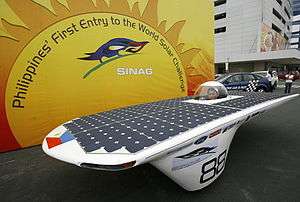
Both of the only two solar cars, SINAG (Tagalog for light beam)[155] and SIKAT (brilliance),[156] of the Philippines were made by DLSU engineering faculty and students. SINAG participated in the 2007 World Solar Challenge, and finished 12th among 40 entries.[157] SIKAT (which has more advanced solar cells, a more aerodynamic body, and 100 kg less weight) will participate in the 2011 competition.[158][159] The project is funded by several private companies, including Ford Philippines, Pilipinas Shell, Philippine Airlines and San Miguel Corporation.[160]
The College of Engineering is among the 18 "National Research Institutions" of the Asian Regional Research Programme on Environmental Technology,[161] a project funded by the Swedish International Development Cooperation Agency and coordinated by the Asian Institute of Technology that seeks to assess environmental degradation in Asia.[162] The college has also conducted research on biodiesel from the pili nut and winged bean,[163] and sustainable technology.[164]
In 2020, De La Salle University captured the attention of British diplomats and scientists with its research on converting wastewater or toilet sludge into nutrient-rich fertilizer. The study aims to find a sustainable alternative to importing phosphates as fertilizer for farms in the Philippines. The research project won ₱13 million from the Newton Fund of the U.K. government.[165][166]
The University's I-Nano facility has initiated a project on developing a Thermal Mechanical Garment (outer layer of a space suit) made from Abaca fiber. This is officially funded by the DOST and to be collaborated alongside the Technological University of the Philippines, FEATI University, Philippine Nuclear Research Institute, and the Philippine Textile Research Institute. The study aims to fabricate a layered structure of fabric out of Abaca fibers coated by a nanocomposite material for electromagnetic interference shielding and thermal resistance.[167][168]
Student life
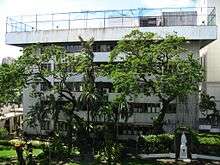
As of 2010, the Council of Student Organizations, a union of DLSU-accredited student organizations, had 39 members.[170] Founded in 1974, the council oversees implementation of university-wide activities, such as annual freshmen welcoming.[171]
The LaSallian (first published in 1960)[39] and Ang Pahayagang Plaridel (Tagalog for The Plaridel Newspaper;[172] first published in 1984)[43] are the official student newspapers of the university. The two, written in English and Filipino respectively, are among the four periodicals managed by the Student Media Office.[173] Other student media groups managed by the Student Media Office include the Malate Literary Portfolio, Green & White, Green Giant FM, and Archers Network.
.jpg)
Performing arts
The De La Salle University Chorale is "the premiere chorale group in the university."[174] Since its establishment in 1987,[43] it has won several awards from different international choir competitions, including the Llangollen International Musical Eisteddfod in 1992 and 2010 for the chamber and folk music,[175][176] and the grand prize in the Tampere Vocal Music Festival in 1995,[177] among others.[178][179]
The La Salle Dance Company – Street is the first champion of the UAAP Street Dance Competition, an annual event organized by the University Athletic Association of the Philippines since it was first introduced in the second semester of UAAP Season 73 in 2011.[180][181] They have won the most number of titles in the seniors' division of the UAAP Street Dance Competition with four championships.[182][183] They also represent the country as frequent finalists in the World Hip Hop Dance Championships. Other groups in the company specialize in contemporary and folk.[184]
Established around 1966, the Harlequin Theatre Guild is the official theater organization of DLSU.[185] It has performed plays written by Palanca Awards laureates, including Unang Ulan ng Mayo (Tagalog for First Rainfall of May) by John Iremil Teodoro, which was staged for the fourth time in December 2011 in line with the LGBT month of Metro Manila[186] and Rizal is My President: 40 Leadership Tips from Jose Rizal by Joshua So based on the book written by Napoleon G. Almonte and staged during the May 2009 Presidential Elections.[187][188] Other notable organizations include the De La Salle Innersoul, Green Media Group, and Lasallian Youth Orchestra.
Sports tradition
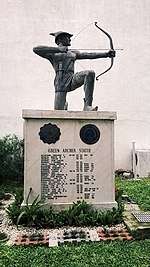
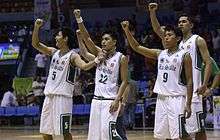
De La Salle has several varsity teams and sport clubs participating in different sports competitions, most notably basketball, volleyball, football and cheerleading.[189][190] The university was a founding member in 1924 of the National Collegiate Athletic Association (NCAA), in which it won five General Championships (1972–73, 1974–75, 1976–77, 1977–78, and 1980–81) until La Salle withdrew from the league in 1981. Br. John Lynam FSC, established the first De La Salle basketball team. In 1924, he was one of the organizers of the pre-war National Collegiate Athletic Association as the first and oldest collegiate athletic association in the Philippines composed of De La Salle, San Beda, Ateneo, Letran, UP, UST, FEU, NU and UM. In 1986, De La Salle University was admitted into the University Athletic Association of the Philippines (UAAP), an intercollegiate sporting association formed in 1938.[43][191] Ever since joining the UAAP in 1986, DLSU has won three UAAP General Championships – Season 75 (2012–13),[192] Season 76 (2013–14),[193] and Season 78 (2015–16),[194] giving the university a combined eight General Championship titles in the seniors' division in the NCAA and UAAP.
The DLSU Animo Squad was originally known in its pre-war NCAA years as Br. John Lynam's 1924 LaS Rah! Rah! Boys, then in 1926 as the LSC Yell Commanders. The DLSC Squad was the first and oldest Collegiate Coed Spirit Team in the Philippines. It was renamed decades later on as the post-war DLSC Cheerleading Squad, then in the 1980s as the DLSU Pep Squad until 2008, when it was renamed by Br. Bernard Oca FSC, as the present DLSU Animo Squad. The DLSU Green & White Spirit Team has since then won five cheer dance podium finishes in the span of its UAAP participation, in 1994, 1996, 1998, 2011 and 2013. The original Lasallian cheerleading spirit team was formally established in 1924 to 1926 with four LaS Rah! Rah! Boys / LSC Yell Command pioneers. Br. John Lynam's pre-war LaS Rah! Rah! Boys, as well his LSC and DLSC Yell Commanders up to Br. Bernard Oca's present DLSU Animo Squad has been continuously cheerleading for 94 years.
The first members of the LaS, LSC and DLSC cheerleading squad were all male until the inclusion of female cheerleaders in the early 1970s. The DLSC cheerleading squad was the first spirit team in the NCAA and the UAAP to have female cheerleaders. The first female DLSC cheerleaders were cross-enrollees from St. Scholastica's College, Manila before De La Salle College turned co-educational in 1973. During De La Salle's pre-war years in the old NCAA, Lasallites enjoyed singing several battle songs such as "Men of La Salle!, "On Into The Fight - Green Archer Song", "Cheer! Cheer! For O'l De La Salle" and several more.
In 1941, the DLSC Green & White yearbook featured a vintage black and white photo of four elementary school boys who proudly wore their Green Archer costumes that formed the first Green Archer Grade School boys mascot cheerleading squad. The tradition of singing Br. Stephen Malachy and Br. Bonaventure Richard's "Hail to De La Salle" Alma Mater Song (composed in 1961) after every Lasallian gathering, event and varsity game while doing the defiant raised, clenched fist "HAIL!, HAIL!, HAIL!" salute has been performed since 1964. This famous Lasallian tradition was defiantly initiated by the DLSC cheerleading squad during the final buzzer of the Green Archers' only winless 1965 NCAA basketball season. At that historical moment, the DLSC Yell Command proudly showcased the indestructible "Invictus La Salle!" school spirit. De La Salle started the tradition of proudly singing the De La Salle Alma Mater Song at the end of all its then-NCAA matches which were later followed by other rival universities and colleges in the NCAA and UAAP.[195]
Partner institution
Malaysia
Notable alumni

Notable alumni from the high school and college of De La Salle include:
- Jose Diokno – Politician
- Lorenzo Tanada – Politician
- Salvador H. Laurel – Politician
- Ramon Magsaysay Jr. – Politician
- Vicente Paterno – Politician
- Lorenzo Tañada – Politician
- Enrique Zobel – Businessman
- John Gokongwei – Businessman
- Jaime Zobel de Ayala – Businessman
- Henry Sy – Businessman
- Enrique K. Razon – Businessman
- Eduardo Cojuangco Jr. – Businessman
- Dennis Uy – Businessman
- J. Amado Araneta – Businessman
- Jorge L. Araneta – Businessman
- Alfonso Yuchengco – Businessman
- José Javier Reyes – Artist
- Virgilio Lobregat – Athlete
- Sebastian Ugarte – Athlete
- Valentin Eduque – Athlete
- Kurt Bachmann – Athlete
- Lim Eng Beng – Athlete
- Renren Ritualo – Athlete
- Ian Lariba – Athlete
- Leo Prieto – Athlete
- Jesus Villamor – World War II Ace Pilot
- Br. Andrew Gonzalez, FSC – Past Education Secretary
- Br. Armin Luistro, FSC – Past Education Secretary
- Cesar Purisima – Past Finance Secretary
- Jose de Venecia Jr. – Speaker of the House of Representatives of the Philippines in 1992–1998 and 2005–2008.[196][197] He graduated from high school at De La Salle College in 1951.[198]
- Leandro Locsin – National Artist of the Philippines for architecture. He graduated from high school at De La Salle College. Many buildings of the campus of University of the Philippines Los Baños and the complex of the Cultural Center of the Philippines were of his design. Istana Nurul Iman, the official residence of the Sultan of Brunei and the largest residential palace in the world,[199] is his grandest work.[200]
Honorary degrees were conferred to the following Individuals:[201]
- Jaime Sin – Archbishop of Manila from 1974[202] to 2003. His influential role was instrumental in staging two nonviolent revolutions in the Philippines (the People Power Revolution in 1986, which resulted in the ouster of Ferdinand Marcos and the restoration of democracy; and the EDSA Revolution of 2001, which resulted in the ouster of Joseph Estrada).[203] He was conferred the degree of Doctor of Humane Letters, honoris causa in 1975.[204]
- Jack Ma – owner of Alibaba Group Chinese e-commerce company that provides consumer-to-consumer, business-to-consumer and business-to-business sales services via web portals. He is one of China's richest men, as well as one of the wealthiest people in Asia, with a net worth of US$46.9 billion, as of October 2017.[205] The degree of Doctor of Science in Technopreneurship, honoris causa was conferred on him in October 2017.[204]
Gallery
- Don Enrique T. Yuchengco Hall
- Halls of the University
- Jean-Baptiste de La Salle, universal patron of teachers
- Psychology Department
- William J. Shaw Theatre
See also
References
- "De La Salle University". De La Salle Philippines. Retrieved May 14, 2011.
- "General Information". De La Salle University. Retrieved May 14, 2011.
- "Linkages with International Organizations". De La Salle University. Retrieved May 14, 2011.
- "External Relations". De La Salle University. Retrieved May 14, 2011.
- "Member schools". Philippine Association for Technical Education. Retrieved May 14, 2011.
- "History: 1970". De La Salle University. Retrieved May 14, 2011.
- Approximate conversion value as of May 2011
- Rene R. Fuentes. "De La Salle University Science Foundation, Inc". De La Salle University. Retrieved May 21, 2011.
- "Quick Facts and Figures". De La Salle University. Retrieved February 13, 2020.
- "Manila Campus". De La Salle University. Retrieved June 22, 2020.
- "The De La Salle University Laguna Campus". De La Salle University. Retrieved June 22, 2020.
- "Why Green and White?". De La Salle University. Retrieved May 30, 2020.
- "Office of Sports Development". De La Salle University. Retrieved July 3, 2020.
- "College history". De La Salle-College of Saint Benilde. Retrieved May 14, 2011.
- "De La Salle Philippines: A Brief History". De La Salle Philippines. Retrieved May 14, 2011.
- "History". De La Salle University. Retrieved May 14, 2011.
- "History: 1920". De La Salle University. Retrieved May 15, 2011.
- Kim Mendoza; David Pagulayan; Lyzette Siazar (January 23, 2011). "Lasallians suffer from limited campus space". The LaSallian. Manila. Retrieved May 16, 2011.
- "WHEN 'LASALLIAN' REPLACED 'LASALLITE'". November 20, 2014.
- "St. John Baptist de La Salle". La Salle. Retrieved July 1, 2020.
- "St. John Baptist de La Salle". De La Salle University. Retrieved July 1, 2020.
- "CHED Recognizes DLSU Programs as Centers of Excellence (COEs) and Centers of Development (CODs)". De La Salle University. January 5, 2016. Retrieved May 22, 2020.
- Jessica B. Natad (June 7, 2010). "CHED grants autonomous status to CDU". The Philippine Star. Retrieved May 14, 2011.
- "PAASCU awards DLSU Level IV status". De La Salle University. Retrieved May 16, 2011.
- "De La Salle University". Quacquarelli Symonds. Retrieved June 3, 2020.
- "DLSU lands in 2019 THE World Rankings". The LaSallian. October 25, 2018. Retrieved June 4, 2020.
- "La Salle joins UP in THE World University Rankings 2019". ABS-CBN News. September 27, 2018. Retrieved September 27, 2018.
- "DLSU is sole PHL private university in the 2019 THE World University Rankings". Medium.com. September 27, 2018. Retrieved September 27, 2018.
- "DLSU joins U.P. in latest Asia university rankings". Rappler. May 5, 2019. Retrieved May 5, 2019.
- Student handbook 2003–06 (PDF). Manila: De La Salle University. June 26, 2003. Retrieved May 15, 2011.
- "The founding (1911–1920): Prologue: A Harty Request". Philippine Lasallian Family. Archived from the original on August 10, 2011. Retrieved May 15, 2011.
- "The founding (1911–1920): The House on Nozaleda Street". Philippine Lasallian Family. Archived from the original on August 10, 2011. Retrieved May 15, 2011.
- Rachel C. Barawid (May 6, 2011). "DLSU through 100 seasons of mission and learning". Manila Bulletin. Retrieved May 15, 2011.
- "The founding (1911–1920): School Year 1911–1912". Philippine Lasallian Family. Archived from the original on August 10, 2011. Retrieved May 15, 2011.
- "History: 1910". De La Salle University. Retrieved May 15, 2011.
- "History: 1940". De La Salle University. Retrieved May 15, 2011.
- "Taft Avenue (1921–1945): War comes to Manila". Philippine Lasallian Family. Archived from the original on March 11, 2012. Retrieved May 15, 2011.
- Andrew Gonzales FSC; Alejandro T. Reyes (February 11, 2008). "Our Martyrs" (PDF). 2401. Manila. 39 (17): 5. Retrieved May 15, 2011.
- "History: 1960". De La Salle University. Retrieved May 15, 2011.
- "History". Asian Institute of Management. Archived from the original on May 2, 2011. Retrieved May 15, 2011.
- "Official name of the university" (PDF). 2401. Manila. 40 (6): 2. August 11, 2008. Retrieved May 16, 2011.
- "Legalities". De La Salle University. Retrieved May 16, 2011.
- "History: 1980". De La Salle University. Retrieved May 16, 2011.
- DJ Yap (September 26, 2010). "Blast rocks end of bar exams at DLSU; 35 hurt". Philippine Daily Inquirer. Retrieved May 16, 2011.
- "DOJ confident prime suspect in De La Salle blast will be arrested". Balita. Philippine News Agency. October 27, 2010. Retrieved May 16, 2011.
- "Students' legs amputated after Manila bombing". Radio France International. September 8, 2010. Retrieved May 16, 2011.
- Doris Franche (April 29, 2011). "La Salle 'bomber' kasuhan! – DOJ". Pilipino Star Ngayon (in Tagalog). Archived from the original on January 31, 2013. Retrieved May 16, 2011.
- Audrey Virgula (November 21, 2010). "DLSU Taft, to partner with Canlubang campus". The LaSallian. Manila. Retrieved May 16, 2011.
- "DLSU to offer senior high school". The Philippine Star. October 31, 2015.
- "DLSU Senior High School Opens Today". The LaSallian. June 1, 2016.
- Annie A. Laborte (September 2007). "The Buildings of La Salle". Benchmark. Supreme Court of the Philippines Public Information Office. Retrieved May 16, 2011.
- "Tomas B. Mapua (1888–1965)" (PDF). National Historical Commission of the Philippines. Archived from the original (PDF) on May 25, 2011. Retrieved May 16, 2011.
- "Retrofitting of St. La Salle Hall". De La Salle University. Retrieved May 16, 2011.
- Augusto Villalon (April 12, 2009). "DLSU building included in int'l best-of list". Philippine Daily Inquirer. Archived from the original on July 26, 2012. Retrieved May 16, 2011.
- "A La Salle Storey". August 6, 2013.
- "History: 1950". De La Salle University. Retrieved May 16, 2011.
- "History". De La Salle Philippines. Retrieved May 16, 2011.
- "Programs and Services". De La Salle University. Retrieved May 16, 2011.
- "Will it stand strong? On DLSU's structural integrity". The LaSallian. August 23, 2012. Retrieved May 30, 2020.
- "Don Enrique T. Yuchengco Hall to be inaugurated". DLSU Newsletter. Manila. 34 (12). June 12, 2002. Archived from the original on July 17, 2011. Retrieved May 16, 2011.
- "DLSU–M inaugurates the Br. Andrew Gonzalez Hall" (PDF). 2401. Manila. 38 (20): 7. March 5, 2007. Archived from the original (PDF) on July 17, 2011. Retrieved May 16, 2011.
- "Edifice for Bro. Andrew". Philip H. Recto Architects. Retrieved May 16, 2011.
- "Enrique M. Razon Sports Center: The history of a landmark". The LaSallian. Retrieved March 5, 2020.
- "Enrique M. Razon Sports Center: The Nucleus of DLSU Fitness". The LaSallian. Retrieved March 5, 2020.
- "DLSU Facts and Figures" (PDF). dlsu.edu.ph. 2012. Retrieved May 24, 2020.
- Jan-Ace Mendoza (December 30, 2010). "It's really happening: Centennial Building construction, commenced". Retrieved May 16, 2011.
- Jessy Go (November 21, 2010). "Presenting… our USG officers!". The LaSallian. Manila. Retrieved May 18, 2011.
- "Rizal Memorial football field up for renovation". GMA News. September 2, 2010. Retrieved May 16, 2011.
- Mike Lee (May 8, 2010). "PSC, La Salle forge deal". Bandera. Manila. Archived from the original on May 10, 2010. Retrieved May 16, 2011.
- Peter Atencio (February 14, 2010). "La Salle eyes football field at Rizal arena". Manila Standard Today. Retrieved May 16, 2011.
- Audrey Virgula (November 21, 2010). "I don't want to die". The LaSallian. Manila. Retrieved May 17, 2011.
- Br. Ricardo P. Laguda FSC (February 14, 2011). "DLSU-DLSC Proposed Merger". De La Salle University. Retrieved May 17, 2011.
- "DLSU Laguna Campus offers 18 undergrad programs in AY 2017–2018". The LaSallian. Retrieved June 29, 2020.
- "BCDA awards last lot in BGC institutional area to DLSU". The Daily Tribiune. September 22, 2013. Retrieved September 22, 2013.
- "DLSU wins bid for Bonifacio lot". ABS-CBN News. September 21, 2013. Retrieved September 22, 2013.
- "De La Salle University Presidents". De La Salle University. Retrieved June 9, 2020.
- "List of Past Presidents 1911-2012". De La Salle University. Retrieved June 12, 2020.
- Oscar Bautista; Victor Ordoñez; Bikas C. Sanyal (1992). "Chapter 1: Institutional background" (PDF). In Joyce Collins (ed.). Change from a semester to a trimester system at the De La Salle University, Philippines. Paris: International Institute for Educational Planning. p. 4. Retrieved May 19, 2011.
- "De La Salle University, Incorporated". De La Salle University. Retrieved June 9, 2020.
- "Office of the President and Chancellor". De La Salle University. Retrieved May 26, 2020.
- "DLSU–Manila opens SY 2007–2008 with new admin posts" (PDF). 2401. Manila. 39 (9): 9. May 30, 2007. Retrieved May 18, 2011.
- Office of the President and Chancellor (July 1, 2010). "Search for a New President of De La Salle University". De La Salle University. Retrieved May 18, 2011.
- "A Tribute to Secretary Andrew Gonzalez FSC Education Secretary, July 1998 – January 2001". Department of Education. Retrieved May 18, 2011.
- Roy Lagarde (July 18, 2010). "Religious brother appointed to state cabinet". CBCP Monitor. Manila. CBCP News. 14 (14): A8. Retrieved May 18, 2011.
- "DLSU Presidents" (PDF). 2401. Manila. 42 (7): 6. June 30, 2010. Retrieved May 18, 2011.
- Ferdinand Fabella (July 12, 2010). "La Sallite heads Taguig university". Manila Standard Today. Retrieved May 18, 2011.
- "University Student Government Constitution" (PDF). De La Salle University. pp. 5, 9–10, 12. Retrieved May 18, 2011.
- "University Student Government Constitution" (PDF). De La Salle University. pp. 17–18. Retrieved May 18, 2011.
- Olivia Estrada; David Pagulayan; Juan Batalla (November 5, 2010). "USG: What difference did it make?". The LaSallian. Manila. Retrieved May 19, 2011.
- Srishti Lakhmani; Olivia Estrada (November 21, 2010). "Eyebrows raised on USG's fund-raising activities". The LaSallian. Manila. Retrieved May 18, 2011.
- "DLSU establishes College of Business and School of Economics" (PDF). 41 (16). Manila: De La Salle University. February 1, 2010: 3. Retrieved May 19, 2011. Cite journal requires
|journal=(help) - "Historical Background". De La Salle University. Retrieved May 19, 2011.
- "History: 1930". De La Salle University. Retrieved May 15, 2011.
- "College of Engineering". De La Salle University. Retrieved May 19, 2011.
- "DLSU launches School of Law" (PDF). 2401. Manila. 40 (21): 3. April 13, 2009. Retrieved May 19, 2011.
- "College of Liberal Arts". De La Salle University. Retrieved May 19, 2011.
- "Graduate Degree Programs". De La Salle University. Retrieved May 20, 2011.
- De La Salle University Undergraduate Viewbook (PDF). Manila: De La Salle University. 2011. pp. 14–49. Retrieved May 19, 2011.
- "BS MEM Specialization in Mechatronics and Robotics Engineering (MEM-MRE)". De La Salle University. Retrieved May 23, 2011.
- "Undergraduate Students". De La Salle University. Retrieved May 14, 2011.
- "Graduate Students". De La Salle University. Retrieved May 14, 2011.
- "Overview". De La Salle University. Retrieved May 19, 2011.
- "Faculty" (PDF). De La Salle University Undergraduate Viewbook. Manila: De La Salle University. 2011. p. 12. Retrieved May 19, 2011.
- "DLSU submits College of Law proposal to CHED" (PDF). 2401. Manila. 40 (4): 3. July 14, 2008. Retrieved May 19, 2011.
- "Freshmen". De La Salle University. Retrieved May 20, 2011.
- "Section 10: Graduation" (PDF). Student Handbook (PDF). Manila: De La Salle University. p. 1. Retrieved May 20, 2011.
- "Graduation". De La Salle University. Retrieved May 20, 2011.
- List of candidates for graduation: 158th Commencement Exercises (PDF). De La Salle University Office of the University Registrar. June 20, 2010. p. 35. Retrieved May 20, 2011.
- List of candidates for graduation: 159th Commencement Exercises (PDF). De La Salle University Office of the University Registrar. October 11, 2010. p. 40. Retrieved May 20, 2011.
- List of candidates for graduation: 159th Commencement Exercises (PDF). De La Salle University Office of the University Registrar. February 3, 2011. p. 28. Retrieved May 20, 2011.
- "Academic Calendar". De La Salle University. Retrieved May 19, 2011.
- "De La Salle University College of Law: Estimated cost of tuition and fees (in Pesos) based on curriculum" (PDF). De La Salle University. pp. 1–4. Retrieved May 20, 2011.
- "Average Tuition Fees for Freshmen". De La Salle University. Retrieved May 20, 2011.
- "Graduate Students". De La Salle University. Retrieved May 20, 2011.
- Ferdinand Marcos (November 11, 1974). Presidential Decree 577 (PDF). Manila: Arellano Law Foundation. Archived from the original (PDF) on September 3, 2011. Retrieved May 20, 2011.
- "Scholarships" (PDF). De La Salle University Undergraduate Viewbook. Manila: De La Salle University. 2011. pp. 7–10. Retrieved May 20, 2011.
- "QS World University Rankings 2020". Quacquarelli Symonds Ltd.
- "World University Rankings 2020". Times Higher Education.
- "De La Salle University". Times Higher Education. Retrieved June 3, 2020.
- "DLSU is most productive Philippine university in research". Business Mirror. March 5, 2020. Retrieved March 25, 2020.
- "DLSU Is One of the Philippines' Biggest Research Powerhouses". Esquire. March 8, 2020. Retrieved March 25, 2020.
- "DLSU leads PH research productivity in 2019". The Manila Times. June 11, 2020. Retrieved June 12, 2020.
- "List of Centers of Excellence and Centers of Development". Commission on Higher Education. October 4, 2010. Retrieved May 14, 2011.
- "2018 University Rankings based on Centers of Development/Excellence". Local Pulse. August 12, 2018. Retrieved May 26, 2020.
- "Ateneo de Manila University". Philippine Accrediting Association of Schools, Colleges and Universities. Archived from the original on October 4, 2011. Retrieved May 20, 2011.
- "Ateneo de Manila University". Association of Christian Universities and Colleges in Asia. Archived from the original on July 25, 2011. Retrieved May 20, 2011.
- "De La Salle University". Philippine Accrediting Association of Schools, Colleges and Universities. Archived from the original on October 4, 2011. Retrieved May 20, 2011.
- "De La Salle University". PAASCU. Retrieved June 18, 2020.
- "History". De La Salle University. Retrieved May 21, 2011.
- "De La Salle University Library, now The Learning Commons!". De La Salle University Library Newsette. Retrieved February 2, 2013.
- William S.A. Frias (January 2008). "Assessment of the DLSU Library's Book Collection on Language and Literature" (PDF). De la Salle University Library Newsette. Manila. 39 (1): 1, 3. Retrieved May 21, 2011.
- Ana Maria B. Fresnido (April 2007). "Assessment of the DLSU Library's Book Collection on Language and Literature" (PDF). De la Salle University Library Newsette. Manila. 38 (4): 1, 4–6. Retrieved May 21, 2011.
- "World History, Philosophy and Religion Collections Assessed" (PDF). De la Salle University Library Newsette. Manila. 37 (3): 1, 3. March 2006. Retrieved May 21, 2011.
- William S.A. Frias (December 2001). "Assessment of the DLSU Library Periodicals Collection" (PDF). De la Salle University Library Newsette. Manila. 32 (11–12): 2. Retrieved May 21, 2011.
- "University Library Increases Borrowing Limit to 30" (PDF). De la Salle University Library Newsette. Manila. 40 (9–10): 1, 5. October 2009. Retrieved May 21, 2011.
- "University Archives". De La Salle University. Retrieved May 21, 2011.
- "Memorabilia, Artwork, and Museum Collections". De La Salle University. Retrieved May 21, 2011.
- "Lasalliana and Other Special Collections". De La Salle University. Retrieved May 21, 2011.
- "De La Salle Museum taps Architect Philip Recto". Philip H. Recto Architects. Retrieved May 21, 2011.
- "About The Museum". De La Salle University. Retrieved May 21, 2011.
- "De La Salle University Science Foundation, Inc". De La Salle University. Retrieved May 21, 2011.
- "De La Salle University Science Foundation, Inc". Philippine Council for NGO Certification. Retrieved May 21, 2011.
- "URCO holds annual tribute to faculty researchers" (PDF). 2401. Manila. 40 (21): 12. April 13, 2009. Retrieved May 22, 2011.
- Br. Armin Luistro FSC (April 13, 2009). "Affirming our commitment to knowledge construction" (PDF). 2401. Manila. 40 (21): 5–8. Retrieved May 21, 2011.
- "The Zonal Research Center". Commission on Higher Education Zonal Research Center NCR Group 1. Retrieved May 21, 2011.
- Ester A. Garcia (March 13, 2000). CHED Memorandum Order No. 3 Series of 2000 (PDF). Pasig: Commission on Higher Education. Archived from the original (PDF) on August 9, 2011. Retrieved May 21, 2011.
- "About Us". De La Salle University Center for Empathic Human-Computer Interactions. Archived from the original on August 13, 2011. Retrieved May 23, 2011.
- "Publications and presentations". De La Salle University Center for Empathic Human-Computer Interactions. Archived from the original on August 29, 2010. Retrieved May 23, 2011.
- "Parallel Paper Presentation Schedule" (PDF). Osaka University School of Engineering. September 30, 2010. pp. 1–4. Archived from the original (PDF) on March 24, 2012. Retrieved May 23, 2011.
- "CCS demonstrates first RP's empathic computing space" (PDF). 2401. Manila. 41 (13): 3. December 1, 2009. Retrieved May 23, 2011.
- "COE, JICA form partnership through rural electrification project". DLSU Newsletter. Manila. 34 (46). April 14, 2003. Retrieved May 23, 2011.
- "History: 2000". De La Salle University. Retrieved May 23, 2011.
- Alvin Culaba. "Chapter 6: Governance and resource issue in the Philippine R & D" (PDF). Energy and Environment Report: A focus on renewable energy research and development in the Philippines. Asia and Pacific Centre for Transfer of Technology. p. 54. Retrieved May 23, 2011.
- "Center for Micro-Hydro Technology for Rural Electrification" (CeMTRE)" (PDF). NGO–JICA Japan Desk Newsletter. Makati. 9: 1–2. November 2005. Retrieved May 23, 2011.
- Leo James English (1987). Tagalog – English Dictionary (2nd ed.). Mandaluyong: Cacho Hermanos. p. 1238. ISBN 971-08-4357-5.
- Leo James English (1987). Tagalog – English Dictionary (2nd ed.). Mandaluyong: Cacho Hermanos. p. 1221. ISBN 971-08-4357-5.
- "SINAG Finishes World Solar Challenge with a Day to Spare". De La Salle University. September 27, 2007. Retrieved May 23, 2011.
- "Sleeker solar car launches RP tour". Manila Bulletin. January 13, 2010. Archived from the original on June 9, 2011. Retrieved May 23, 2011.
- "New solar car kicks off nationwide tour" (PDF). 2401. Manila. 41 (15): 3. January 18, 2010. Retrieved May 23, 2011.
- "The SINAG Project". De La Salle University. Retrieved May 23, 2011.
- "NRIs by country". Asian Regional Research Programme on Environmental Technology. Retrieved May 23, 2011.
- "Official website". Asian Regional Research Programme on Environmental Technology II. Retrieved May 23, 2011.
- "College of Engineering". De La Salle University. Retrieved May 23, 2011.
- "Sustainable Technologies Research Group". De La Salle University. Retrieved May 23, 2011.
- "La Salle scientist and team win P13-M Newton Prize for fertilizer research". Rappler. January 30, 2020. Retrieved June 12, 2020.
- "DLSU Wins P13 Million for Research on Turning Toilet Sludge Into Fertilizer". Esquire. February 20, 2020. Retrieved June 12, 2020.
- BMPlus (February 13, 2020). "DLSU's I-Nano facility embarks on DOST's spacesuit project". BusinessMirror. Retrieved March 2, 2020.
- "DLSU Developing Spacesuit Made With Abaca Fiber". Esquire. February 22, 2020. Retrieved June 12, 2020.
- "Office of the Dean of Student Affairs". De La Salle University. Retrieved May 24, 2011.
- "CSO miscalculates accreditation grades of student orgs". The LaSallian. Sandi Suplido. December 30, 2010.
- "Council of Student Organizations" (PDF). De La Salle University. Retrieved May 24, 2011.
- Leo James English (2007). Tagalog–English Dictionary (2nd ed.). Cacho Hermanos. p. 966.
- "Student Publications". De La Salle University. Retrieved May 24, 2011.
- "Section 1.3.6: Performing arts groups" (PDF). Operations manual AY 2010–2011. Manila: De La Salle University Cultural Arts Office. 2010. p. 5. Retrieved May 24, 2011.
- Public Information Service Unit (July 16, 2010). "RP Choirs Shine in UK Competition – UST Singers Win "Choir of the World" Award". Department of Foreign Affairs. Retrieved May 24, 2011.
- Rose Eclarinal (July 9, 2010). "DLSU Chorale serenades Pinoys in London". ABS–CBN Europe News Bureau. Retrieved May 24, 2011.
- "History". Tampere Music Festivals. Retrieved May 24, 2011.
- Dean of Student Affairs (July 29, 2010). "[DSA] DLSU Chorale garnered awards during their European Tour". De La Salle University. Retrieved May 24, 2011.
- "De La Salle University Chorale In Concert" (PDF). Philippine Embassy to the United Kingdom.
- Angel Bombarda (March 23, 2011). "LSDC-Street: The La Salle kind of dance". Manila Bulletin. Retrieved May 24, 2011.
- Anthony Divinagracia (March 13, 2011). "La Salle wins UAAP street dance tilt". University Athletic Association of the Philippines. Retrieved May 24, 2011.
- "La Salle reclaims UAAP street dance crown". Rappler. March 23, 2019. Retrieved May 30, 2020.
- "La Salle wins record 4th UAAP streetdance crown". ABS-CBN News. March 23, 2019. Retrieved May 30, 2020.
- "Section 1.3.6: Performing arts groups" (PDF). Operations manual AY 2010–2011. Manila: De La Salle University Cultural Arts Office. 2010. pp. 4–5. Retrieved May 24, 2011.
- "Harlequin Theatre Guild: Love Express". De La Salle University. Retrieved May 24, 2011.
- ""Unang Ulan ng Mayo" to be staged from October 9–11". Philippine Entertainment Portal. October 6, 2008. Retrieved May 24, 2011.
- RDA (March 2010). "AdU Theater presents "Rizal is My President"". Adamson University. Archived from the original on July 21, 2011. Retrieved May 24, 2011.
- "DLSU's Harlequin presents 'Rizal is My President'". The Philippine Star. August 14, 2009. Retrieved May 24, 2011.
- "Overview". De La Salle University. Retrieved May 24, 2011.
- "Sports Clubs". De La Salle University. Retrieved May 24, 2011.
- "University Athletic Association of the Philippines". De La Salle University. Retrieved May 24, 2011.
- "DLSU wins first UAAP General Championship". GMA. Retrieved February 16, 2020.
- "La Salle crowned UAAP Season 76 overall champions". Rappler. Retrieved February 16, 2020.
- "La Salle overall champ in UAAP; UST second". The Philippine Star. Retrieved February 16, 2020.
- "ANIMO La Salle!". The Philippine Star. Retrieved February 16, 2020.
- "Speaker Jose De Venecia of the House of Representatives, Congress of the Philippines" (PDF). Global Organisation of Parliamentarians Against Corruption. Retrieved May 24, 2011.
- Maila Ager (February 5, 2008). "De Venecia ousted, Nograles is Speaker". Philippine Daily Inquirer. Retrieved May 24, 2011.
- "Curriculum vitae: Hon. Jose De Venecia Representative 4th District, Pangasinan" (PDF). Congress of the Philippines. pp. 1, 5. Retrieved May 24, 2011.
- "Istana Nurul Iman". Arabia MSN. Archived from the original on August 7, 2011. Retrieved May 24, 2011.
- "Leandro V. Locsin". Arkitekturang Filipino. Retrieved May 24, 2011.
- IRPA, DLSU ITS, DLSU STRATCOM, DLSU. "De La Salle University : Office of the University Registrar : Honorary Degree Awardees". www.dlsu.edu.ph. Retrieved March 26, 2018.
- "Appointments and Positions of Significance". Archdiocese of Manila. Retrieved May 24, 2011.
- Michelle O'Donnell (June 1, 2005). "Cardinal Jaime Sin, a Champion of the Poor in the Philippines, Is Dead at 76". The New York Times. Retrieved May 24, 2011.
- "Honorary Degree Awardees". De La Salle University. Retrieved May 24, 2011.
- "Chinese billionaire Jack Ma 'extremely humbled' by honorary degree from DLSU". GMA News. October 25, 2017. Retrieved October 25, 2017.
